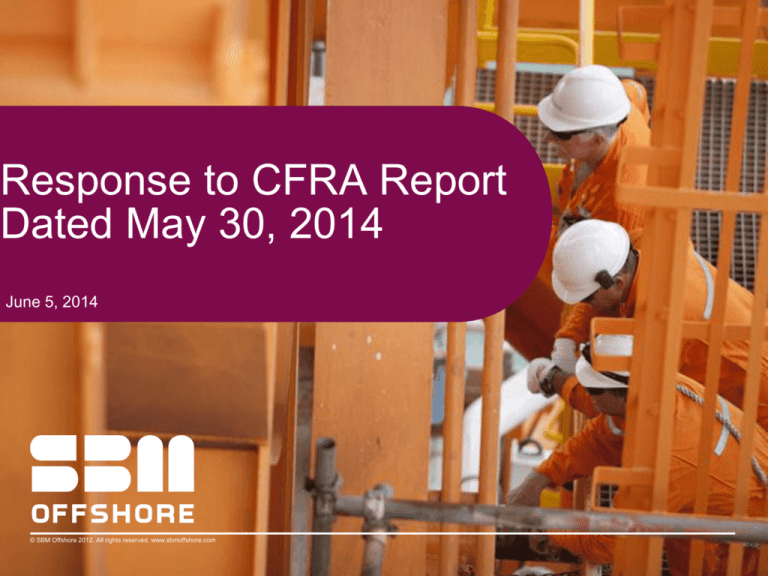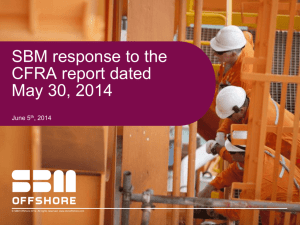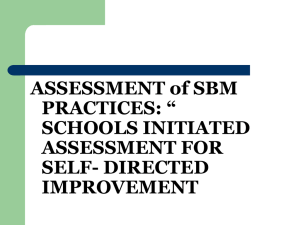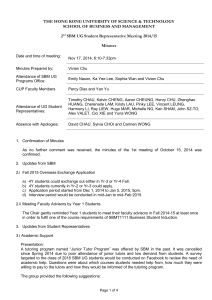
Response to CFRA Report
Dated May 30, 2014
June 5, 2014
© SBM Offshore 2012. All rights reserved. www.sbmoffshore.com
Introduction
On May 30, 2014 CFRA (a forensic accounting research firm) issued a report on SBM Offshore
raising a number of concerns regarding the Company’s accounts and financial reporting.
In the slides that follow, SBM Offshore provides its own views on the concerns raised. Namely, that
CFRA misses the intricacies of IAS17 (Finance Lease Accounting) in combination with IAS11
(Project Accounting).
Over the course of the last 12 months SBM Offshore has repeatedly drawn the attention of the
investment community to the aggressive nature of IFRS revenue and profit recognition and has
provided a credible alternative by reporting ‘Directional Results’ that much more closely follow the
reality of invoiced revenue and cash flow.*
SBM’s Management Board remains confident that it provides the necessary transparency in its
financial reporting.
The Management Board
Schiedam, June 5, 2014
*2013 Annual Report, Chapter 3.1.3, Page 57; 1H 2013 and FY 2013 Press Releases; Project Direction Teach-In Presentation (June 2013):
http://www.sbmoffshore.com/wp-content/uploads/2013/06/Project_direction_presentation_20062013.pdf
2
Rise in Receivables
Concern: “Significant increases in both construction DSO and finance lease receivables, both nominally
and in days (DSO), raise concern about potentially aggressive revenue recognition and the ability of SBM
to sustain its current level of business moving forward.”
Response:
• SBM’s revenue recognition policy under IAS11 is prudent given that (i) revenues are recognized
proportionally to costs incurred and thus not subject to management estimates and (ii) include a 25%
margin threshold before recognizing margin.
• SBM has pro-actively disclosed the discrepancies between IFRS revenue recognition, which accelerates
lease and operate revenue into the construction phase for finance leases, and cash income. To that
effect, SBM introduced its Directional revenue standard in mid-2013 to counterbalance the aggressive
stance taken by IAS17 relating to finance lease projects under construction in order to reach a fair
measure of revenue that is more in line with cash flows.
• The reported increase in construction DSO is solely driven by growing finance lease investments. Of the
US$1.7 billion in unbilled Work In Progress, US$1.6 billion is related to the SBM share in the N'Goma,
Cidade de Ilhabela, Stones, and Cidade de Marica and Saquarema projects under construction.
• These ongoing investments will generate strong and sustainable Directional revenue following start of
production in 2015 (N'Goma and Ilhabela) and 2016 (Stones, Marica and Saquarema).
Conclusion: Rise in receivables a direct consequence of the application of IAS17 and IAS11, and would
be reflected as ‘fixed assets under construction’ on the balance sheet under operating lease accounting.
3
Looser Financing Terms
Concern: “Are looser financing terms driving unsustainable revenue growth? SBM may also be supporting
an unsustainable level of business by providing customers with increasingly lengthy finance receivable
terms.”
Response:
• First of all, revenue recognition is disconnected from financing terms related to lease contracts.
• Secondly, the lease contract duration is related to the production capacity of the oil field which for large
deep water fields is increasing to 20 years (Brazil) compared to 10 to 15 years historically.
• Longer contracts also mean significant additional and recurrent revenue generated by operating and
maintaining those vessels over 20 years.
• On the funding side, the longer duration of the Brazilian contracts leads to longer maturity of project loans
to better match the cash inflows.
• Finally, IFRS revenue recognition shows a substantial portion of the future lease revenue during the
construction period of the FPSO, with a marked decline in annual revenue following start-up (deemed
interest on the reducing finance receivable). Under Directional reporting, annual net income during the
lease period goes up, as a consequence of the lower interest paid on the declining funding loans.
4
Non-Recurring Items
Concern: “2014 earnings may face headwinds from the non-recurrence of material earnings benefits
realized in 2013.”
Response:
• The Company regards provisioning for possible warranty claims and bad debts as normal course of
business. The related expenses are not corrected for underlying results, nor are write-backs.
• Warranty provisions increased year-on-year in 2013 to US$41 million from US$35 million while bad debt
provisions remained stable at US$17 million versus US$18 million in 2012. This implies that SBM’s 2013
results were not generated by an exceptional release of provisions.
• The calculation of warranty provision at SBM has been consistent for years and based on a fixed
percentage of the Company’s construction revenues. No change of method was applied in 2013.
• Actual expenses under warranty claims in 2013 significantly decreased compared to 2012 as a result of
fewer quality claims on SBM products and better contract management.
• Bad debt expenses incurred in 2013 decreased significantly as a result of (i) a more aggressive cash
collection approach and (ii) a more prudent approach to provisioning.
5
Payables Increase
Concern: “Increasing payables, both on a nominal basis and measured in days (DSP), may have boosted
2H13 cash flow from operations (CFFO) and partially mitigated significant degradation in 2H13 free cash
flows (FCF).”
Response:
• Due to the nature of the construction business, trade payables should not be looked at in isolation but
together with accruals.
• FPSO projects generate large subcontracts placed with large equipment manufacturers and construction
yards which generate a high level of unbilled work, leading to significant accruals on projects.
• The combination of trade payables & accruals went up from US$900 million in 2012 to US$992 million in
2013. This increase remains in line with activity growth reflecting IFRS growth of costs of sale.
• Free Cash Flow remained negative in 2013 due to the significant project investments by the Company
reflecting the increase in SBM’s backlog on lease and operate contracts (turnkey contracts are pre-paid
in installments by the client).
6
Other Receivables
Concern: “A significant increase in other receivables raises concern about the health of SBM’s suppliers.
SBM’s other receivables climbed to a historic high in both nominal terms and measure in days (DSO).”
Response:
• The increase from US$61 million in 2012 to US$324 million in 2013 is due to the significant backlog
increase and a one off item:
• Advance payments made to construction yards related to the commencement of work on FPSO Stones
and FPSOs Marica and Saquarema for US$150 million.
• Disposal of the Monaco Concorde office building in December 2013 for US$84 million which was paid
in Q1 2014.
7
Directional Reporting
Concern: “We question the merits or lack thereof of SBM’s directional reporting and are concerned that the
measure may be more easily “managed” than IFRS-conforming results.”
Response:
• Directional reporting treats all finance lease contracts as if they were operating leases. All IFRS rules
regarding operating leases are strictly applied.
• In effect, by treating financial leases as an operating lease, a significant element of judgment is removed
as finance leases are valued at discounted present value where the discount rate is subject to
management judgment and changes could affect income considerably.
• Directional revenue recognition during the construction phase, where the Joint Venture partners are
contributing their share in the FPSO costs, is not based on client invoicing but on cost progress.
• Directional revenues are much closer to cash flows than IFRS, but not equal to cash flows. Directional
revenues still include accrued income or deferred revenue when invoicing to client occurs later than
progress or sooner.
8






